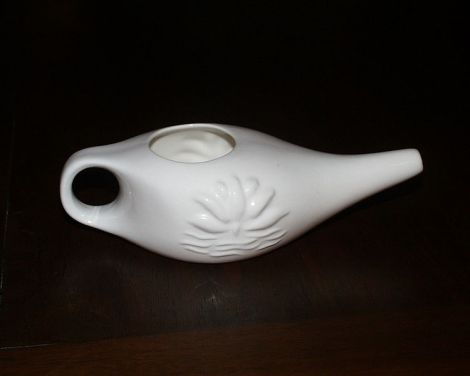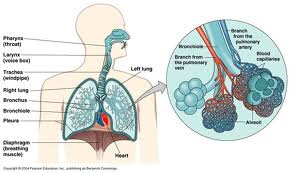The upper respiratory system consists of the sinuses, ears, throat ( basically, everything above the neck). Respiration exists as an exchange of gases between the inside and the outside of the body. External respiration is the exchange of gasses between the external environment and inside of the body (especially the blood stream and respiratory organs). Internal respiration is the exchange of gasses between the bloodstream and the cells plus the use of these gasses by the cells (cellular respiration).
Cilia in the nasal cavity and sinus mucus membranes filter particles from what is about o enter the lungs. Breathing through the mouth is problematic because it doesn’t moisten the air or filter particles, which actually makes the body more acidic. The nasal cavity serves several functions:
- Nasal cavity is a resonating chamber for vocalization.
- Nasal cavity houses olfactory receptors; smell being the most primitive of senses.
- The chonchae (three shelf-like projections in the nasal cavity) turbinate the air at a great velocity.
The nasal cavity is divided into right and left septum and separated by the oral cavity, which contains the hard and soft palette. The soft palette closes off the nasal cavity while eating. This architecture is developed in an infant during breastfeeding. Problems in the architecture of the nasal and oral cavity can present as a deviated septum or collapse of the eustachion tubes of the middle ear. Orthodontic crania-sacral therapists have had great success in remedying these problems.
The sinuses warm the air and moisten it before entering the lungs. They serve several other jobs as well:
- reduce the weight of the skull
- additional resonating chambers for vocalization.
- produce mucus that traps particles
- bring in air to cool the pituitary gland. This occurs in the sphenoidal sinus.
Keep your sinuses in “ship shape” with a Netti Pot. It looks like a little ceramic lantern that you can buy at most drugs stores and health food stores. Proper technique is key for success with the Netti Pot. Follow this recipe:
1 cup of water
1/4 tsp salt
Pass the water through both sides and then GENTLY blow nose.
Your throat is intrinsically linked to your lymphatic system. We treat many infections, such as strep with antibiotics. The energy of antibiotics are cold while infections are a condition of heat. This dichotomy causes quite a bit of complications with antibiotics. We Want to mitigate these side effects with warming herbs, teas, and probiotics.The pharynx connects the nasal and oral cavities and also contains ciliated mucosa, tonsils/ adenoids, which are a mass of lymphatic tissue. Health of the respiratory mucosa effects ear health.
Your ears; the tympanic membrane is very sensitive. Children have their ears in line with their nose, which makes them more prone to ear infections. When an ear infection occurs it is very important to eliminate milk and sugar for 2-3 days.
- Echinacea is the tincture of choice to use orally for ear infections. The dosage would be 1/2 of a persons body weight in drops 3-4 times / day.
- Mullein oil from the flowers: anti microbial for ear infections. The warmed oil goes inside the ear. You may make your own mullein oil. Cut the stalk and and put it in water, gather the flowers as they appear and put them into olive oil.
- Heat rock salt (the salt you’d use to make iced cream) in a sock and put it behind the ear for a very soothing and simple ear-ache remedy.
The larynx contains the epiglottis, which keeps food from going into the lungs. The cilia in the larynx move in an upward motion. The voice box opens into the trachea, attached to the hyoid. The trachea or windpipe, in front of the esophagus is made of cartilage. The bottom of the trachea enters the bronchi, which get smaller and smaller (bronchioles). Less cartilage and mucus exists towards the end ; bronchioles end up in alveolar ducts- tiny tubes that alveoli are attached to.
The aveoli are microscopic sacs, which increase the surface area in the lungs. This surface are increases the amount of capillary (blood carrying) distance. The primary vehicle in the capillary is the red blood cell (carrying hemoglobin). Hemoglobin is the molecule which attracts oxygen and is made of iron. Hemoglobin is almost identical to chlorophyl, but chlorophyl has magnesium in it. White blood cells from the alveoli patrol for infections and foreign particles. It is important to stay hydrated to avoid allergies, keep mucus membranes and pleura well lubricated. Better hydration occurs with the use of natural salts and electrolytes.
Pleura is a double layered membrane: one layer attaches to the lungs and the other to the ribcage. Serous is a slippery fluid between the two layers. When it dries up it causes a condition called pleurisy, which is very painful friction and inflammation of the membranes. If the outer pleura is punctured, the lungs collapse.
In the lungs, we experience much of the mechanics of breathing, as sympathetic fibers cause smooth muscles to relax and surfactant secreted, decreases surface tension- thin membranes stay expanded. The diaphram is the primary muscle of ventilation- moving air in and out of the lungs. When it is relaxed the lungs are smaller, when it is contracted, the lungs are expanded.
 When we have lung issues, often the lungs need to be cleared of mucus and debris. To do this we want to bring blood to the chest. Vicks vapor rub or eucalyptus with olive oil rubbed on the chest works great. Never use an essential oil straight , but always cut it with a “carrying” oil, as pure essential oils may burn the skin. To encourage a productive cough, try a steam with rosemary, thyme, or sage- inhale deeply.
When we have lung issues, often the lungs need to be cleared of mucus and debris. To do this we want to bring blood to the chest. Vicks vapor rub or eucalyptus with olive oil rubbed on the chest works great. Never use an essential oil straight , but always cut it with a “carrying” oil, as pure essential oils may burn the skin. To encourage a productive cough, try a steam with rosemary, thyme, or sage- inhale deeply.
When mucus is an issue, avoid orange juice, citrus, milk, and sugar as these things only produce more mucus. A good herbal remedy for the lungs is sweet violet ( viola oderata). Violet is a fabulous lung tonic, which you may be able to find in abundance in your very front yard! Make a tea or tincture from the leaf and flower, which is demulcent, soothing, and will break through phlem.
 Goldenseal will dry up and tone mucus membranes and it destroys bacteria. The phytotherapist always uses goldenseal for bacterial infections and echinacea for viral. Echinacea produces interferons, which keep the virus from attaching to RNA lysosomes.
Goldenseal will dry up and tone mucus membranes and it destroys bacteria. The phytotherapist always uses goldenseal for bacterial infections and echinacea for viral. Echinacea produces interferons, which keep the virus from attaching to RNA lysosomes.
Now, let’s look at some more specific “lung herbs”:
Nettles: (urtica diocia) “drain damp” ( traditional Chinese medicine), important for lung nourishment Because it is high in minerals, ” builds blood”, high in bioavailable iron.
Plantain (plantago major): This strongly drawing and pulling herb can draw mucus out of the lung when taken in a tea form.
Ground Ivy ( glechoma hederacea) : This is a fabulous sinus drainage plant, an analog to goldenseal. It can be used as a tea or a tincture.
Black cohosh (cimicifuga racemosa): menapause, anti-spasmodic, wind expectorant.
Ella campaign (inula helenium): contains inulin- a type of starch, warming expectorant, building to digestion, drains mucus, bitter. White or clear mucus would be an I dictation for inula helenium. This spicy, carminitive moves digestion, a favorite root medicine of the phytotherapist.
Mullein (verbascum thapsus): Cooling and demulcent herb, that estranges and cuts through mucus. Works great as a steam with tickley coughs.
Thyme (thymus vulgaris): this herb is antiseptic. Makes a nice syrup or tea: hot and spicy.
Rosemary (rosmarinus officianalis): antioxidant, circulatiry promoter, steam to help decongest.
Pleurisy Root/ Butterfly Weed (asclepias tuberosa): good for asthma and inflammation of the pleura.
Hyssop (hyssopis officionalis): medicinal hyssop opens up passages. It’s energy is diffusive and warming. It breaks up hardened mucus and makes a lovely syrup.
Wild Ginger (asarum caudatum): root medicine, calming nervine, helps with coughs, clears the sinuses with its hot ans spicy energy.
